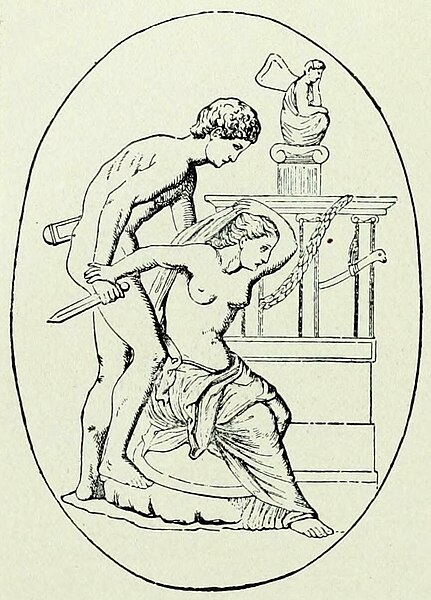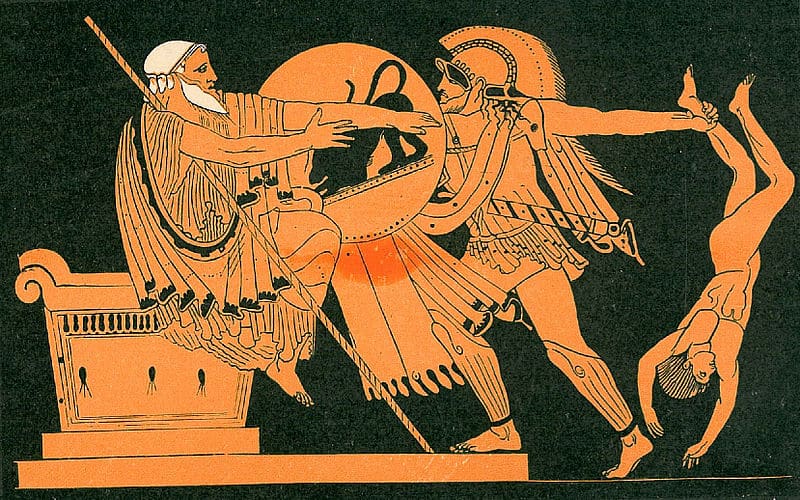In the vast web of Greek mythology, Neoptolemus stands out as a figure of both valor and volatility. As the son of the legendary Achilles, Neoptolemus’s narrative is one of courage, retribution, and the intricate interplay of destiny.
Neoptolemus Key Facts
| Parents | Achilles and Deidamia |
| Partners | Andromache, Hermione |
| Siblings | None |
| Offspring | Molossus, Pergamus, Pielus |
| Other names | Pyrrhus |
| Roman name | Pyrrhus |
| Best Known Myth | His role in the fall of Troy |
Name and Etymology
Neoptolemus, occasionally referred to as Pyrrhus, carries a name steeped in significance. “Neoptolemus” translates to “young warrior,” a fitting moniker for the spirited son of Achilles, who assumed his father’s mantle at a young age. The alternate name “Pyrrhus” stems from the Greek word for “flame-colored” or “red,” perhaps hinting at his fervent nature or the blood he spilled in battle.
In Roman tales, he is often called Pyrrhus, echoing his fiery reputation. Over the ages, various epithets and titles were attributed to him, each encapsulating a different aspect of his multifaceted persona. From the fierce avenger of his father’s demise to the young hero thrust into prominence, each name narrates a tale.

Neoptolemus’ Family and Relationships
Born to the formidable Achilles and the princess Deidamia, Neoptolemus was predestined for greatness. While Achilles met his tragic demise at Troy, young Neoptolemus was nurtured in the court of his grandfather, King Lycomedes. His upbringing, though sheltered, was colored by tales of his father’s heroism, setting the stage for his own legendary journey.
As he grew, Neoptolemus’s life intertwined with several iconic figures. He wed Andromache, Hector’s widow, and later, Hermione, the offspring of Helen and Menelaus. These alliances, both strategic and heartfelt, played crucial roles in the post-Trojan War era.
Myths about Neoptolemus
Neoptolemus’s journey through Greek mythology is a tapestry of valor, passion, and the inexorable hand of fate. Each myth paints a facet of his character, revealing the depth and complexity of this legendary hero.
The Fall of Troy
Upon his arrival at the shores of Troy, Neoptolemus quickly became a beacon of hope for the beleaguered Greeks. Emulating his father, Achilles, he showcased unparalleled bravery. One of his most notable deeds was the slaying of the elderly king Priam, marking a symbolic conclusion to the Trojan resistance. This act, while showcasing his warrior prowess, also highlighted the brutal realities of war, as he ended the life of the Trojan king at the altar of Zeus.
Marriage to Andromache
After the fall of Troy, Neoptolemus claimed Hector’s widow, Andromache, as a war prize. Their union was marked by its complexities. Andromache, still mourning her lost husband and homeland, found herself in a foreign land, bound to the son of Achilles, her husband’s killer. Yet, over time, a bond formed between them, leading to the birth of their son, Molossus. Their relationship is a testament to the intricate dance of love, duty, and fate in the aftermath of war.
The Perilous Return Home
Neoptolemus’s voyage back from Troy was anything but smooth. He faced a series of challenges, both natural and supernatural. One such trial was his encounter with the aged king Telephus, whom he healed using the rust from Achilles’ spear, showcasing not just his warrior skills but also his knowledge of ancient rites. His journey also took him to the island of Delos, where he paid homage to the god Apollo, seeking blessings for a safe passage home.
Union with Hermione
Amidst a web of intrigue, jealousy, and conflict, Neoptolemus’s relationship with Andromache became strained. The exact circumstances of their estrangement remain shrouded in myth and interpretation. Some say Neoptolemus, under pressure and for the sake of political peace, distanced himself from Andromache, relegating her to a secondary position. Others suggest that Andromache, chose to leave Neoptolemus’s side.
Regardless of the reasons, the once-strong bond between Neoptolemus and Andromache weakened, making way for Hermione’s prominence in his life. Neoptolemus’s marital life took another turn when he wed Hermione, the daughter of Helen and Menelaus. This union was steeped in political strategy, aiming to solidify alliances in the post-war landscape. However, the marriage was tumultuous, with Hermione harboring deep resentment towards Andromache, leading to a web of intrigue, jealousy, and conflict.
Conflicts in Epirus
Upon his return to Epirus, Neoptolemus found himself embroiled in a series of conflicts. His claim to the throne was contested, leading to political intrigue and battles. His decisions, often driven by a mix of youthful impetuosity and the weight of his legacy, shaped the future of his kingdom.
The Death of Neoptolemus
In a tragic twist of fate, Neoptolemus met his end in Delphi. His death was foretold, and in a bid to change his destiny, he sought the oracle’s guidance. However, a conflict arose at the temple of Apollo, leading to his untimely demise. His death, echoing the complexities of his life, was a blend of passion, drama, and the unyielding grasp of fate.
Depiction And Characteristics
Neoptolemus, with his fiery mane and piercing gaze, was often portrayed as a mirror image of his father, Achilles. Symbols linked to him include the spear, signifying his warrior lineage, and the Trojan horse, denoting his crucial role in Troy’s downfall.
His persona, as inferred from myths, was a mix of youthful rashness and seasoned sagacity. While his deeds occasionally bordered on the impulsive, they were always underpinned by a profound sense of honor and duty. The Ancient Greeks perceived him with a blend of reverence and caution, a hero whose flames shone brightly but could also engulf all in its wake.

Representations Of Neoptolemus In Art
Throughout antiquity, Neoptolemus’s saga has kindled the imagination of countless artists. From detailed pottery illustrations to grand sculptures, his likeness is a testament to his enduring legacy. One standout piece is the “Slaying of Priam,” a fresco that captures the raw emotion of that pivotal encounter.
In subsequent eras, Renaissance artists, captivated by Greek mythology, frequently drew from Neoptolemus’s story. His intricate character, a fusion of heroism and tragedy, offered a rich canvas for artistic expression.
Mentions in Ancient Texts
Neoptolemus’s legend is intricately woven into the fabric of numerous ancient texts, each offering a unique perspective on this enigmatic hero.
The Aeneid by Virgil
Written in the 1st century BC by the Roman poet Virgil, “The Aeneid” is a magnum opus that chronicles the journey of Aeneas, a Trojan hero. In this epic, Neoptolemus’s role in the fall of Troy is depicted with both admiration and trepidation. Quote: “Fierce Neoptolemus his falchion drew, to Priam’s altar, at his grandsire’s view, drove through the thickest of the press.”
The Iliad by Homer
Although Neoptolemus doesn’t play a central role in “The Iliad,” penned by the ancient Greek poet Homer around the 8th century BC, the epic foreshadows his future actions and the legacy of his father, Achilles. Quote: “If Neoptolemus is still alive and well, there is no one else in the world who would be a better guardian of your son and your possessions.”
Posthomerica by Quintus of Smyrna
Composed in the 4th century AD, “Posthomerica” by Quintus of Smyrna bridges the gap between Homer’s “Iliad” and “Odyssey.” It delves into the events after Hector’s death, including Neoptolemus’s exploits. Quote: “Neoptolemus, with his father’s might, stormed forward, his spear shimmering with deadly intent.”
Andromache by Euripides
Euripides, one of the great tragedians of classical Athens, penned “Andromache” in the late 5th century BC. This play delves into the life of Andromache, Neoptolemus’s wife, post the Trojan War, offering insights into their tumultuous relationship. Quote: “For Neoptolemus has taken another wife besides me, and having a child by her, he pushes me aside.”
Frequently Asked Questions
Neoptolemus was the offspring of the legendary warrior Achilles and princess Deidamia.
The alternate name “Pyrrhus” means “flame-colored,” reflecting his fervent nature and the blood he shed in battle.
Neoptolemus was instrumental in Troy’s downfall, notably ending the life of King Priam during the city’s final hours.
He wed Andromache, widow of Hector, and subsequently, Hermione, daughter of Helen and Menelaus.
Neoptolemus faced a tragic end in Delphi, perishing in a conflict at Apollo’s temple.
Indeed, numerous artworks, especially from the Renaissance, depict Neoptolemus’s deeds, with the “Slaying of Priam” being particularly renowned.
Featured Image Credit: François-Xavier Fabre, Public domain, via Wikimedia Commons

